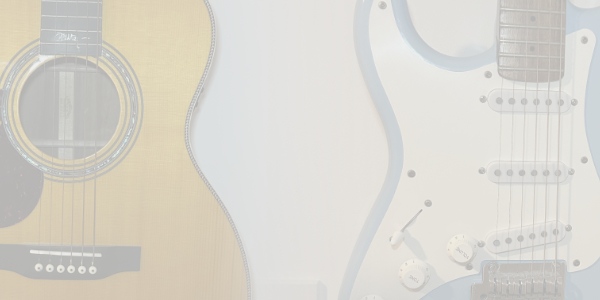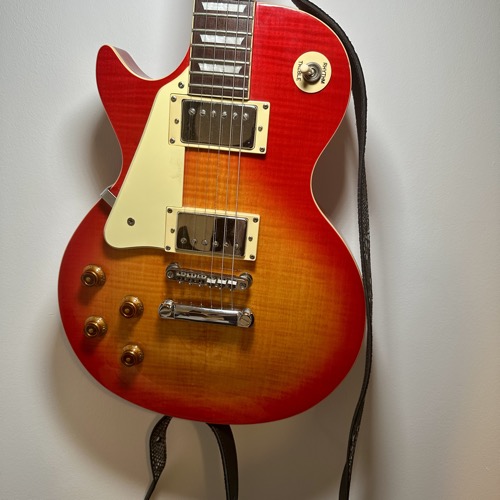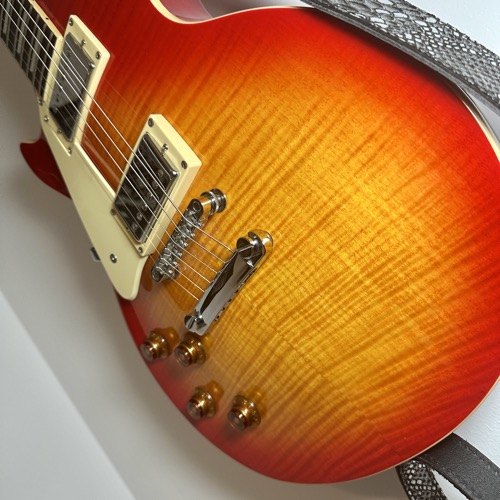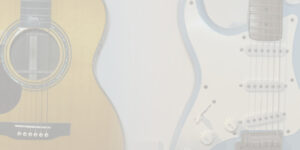
The Affordable Vintage Les Paul – Is Epiphone the best way to get into “Vintage Guitars”?
Introduction
I believe that, deep down, everyone would love to own a vintage Gibson Les Paul. Not only are these guitars incredibly cool, but they also represent a significant chapter in guitar history. However, it’s fair to say that vintage Gibson Les Pauls come with a hefty price tag. Fortunately, there’s an alternative that offers the essence of a vintage Les Paul at a much lower cost: the Epiphone Les Paul, often regarded as Gibson’s more affordable younger brother.
I’m excited to share that I managed to acquire a left-handed Epiphone Les Paul in excellent condition. This particular guitar is quite special, and I’ll explain why in a moment. In this article, I’ll explore why more people should consider Epiphone Les Pauls—and why these underrated instruments offer a great “Vintage Les Paul” experience without the premium price. But first, let’s dive into a bit of history about the Epiphone Les Paul, starting all the way back in 1989.
A Brief History of the Epiphone Les Paul
Epiphone was founded in 1873, but the company didn’t begin manufacturing guitars until 1928, when it started producing instruments designed to rival Gibson. In 1957, Gibson purchased Epiphone. The Epiphone Les Paul was first introduced in 1989—37 years after the debut of the iconic Gibson Les Paul. Initially produced in Korea, production later moved to China in the early 2000s. Korean-made Epiphone Les Pauls are widely regarded as high quality and offer excellent playability; I’ll delve into those details later.
You might assume that these vintage, Korean-made Les Pauls are hard to find and come with a hefty price tag. However, that’s not the case! If you know what to look for, you’ll find that there are quite a few available at very affordable prices—often even cheaper than newer Epiphone models. Personally, I purchased a left-handed, Korean-made Epiphone Les Paul in my favorite color. Let’s take a closer look at this unique instrument and explore why it’s an excellent alternative for anyone seeking a vintage Les Paul experience without the premium cost.
My Vintage Les Paul

Story behind my Epiphone Les Paul Standard?
The guitar I purchased is a 1999 model in Heritage Cherry Sunburst—one of my favourite colours on a Les Paul. I initially tried my very best to find a 1989 model, but couldn’t locate one until after I bought this one. As far as I can tell, the instrument is entirely original aside from a few minor issues, which we’ll cover shortly. The fretwork is outstanding, the finish is beautiful, and—apart from the headstock—the guitar looks far more valuable than it actually is.
What are these issues?
The most significant problem is with the tuners. One machine head has been replaced—presumably because the original snapped off—and it has been swapped with a Kidney-style tuner. There are also a few minor cosmetic issues: a small crack in the binding around the third fret and a few very light scuffs on the back, which are typical for a guitar of this age. Overall, however, the appearance of the guitar remains impeccable.
How does it sound and play?
Simply put, it sounds just like a classic Les Paul! This Epiphone Les Paul Standard offers abundant sustain and is a joy to play. The pickups are standard—the neck pickup delivers that warm, creamy tone we all love, while the bridge pickup is cutting and powerful. I do feel that the neck pickup is slightly quieter than expected, but this can easily be remedied with a pickup adjustment. Overall, this guitar provides everything you’d want from a Les Paul, covering the signature rock and metal tones as well as the smooth blues and country sounds. There aren’t many sonic possibilities that this instrument cannot achieve!
How much did I pay for this 26-year-old guitar?
Just under £400! That’s an incredible deal for a Vintage Les Paul experience—especially when you consider that a brand-new Les Paul would cost significantly more today. That said, there are a few modifications I plan to make. Firstly, I intend to source a matching machine head to replace the mismatched one; if necessary, I may replace all of them to ensure consistency. Secondly, I might upgrade the potentiometers (pots), as they don’t seem very responsive. For example, the volume pot has a very slight taper and then nothing until it reaches zero. In the future, I might replace them with CTS pots, as I have some lying around that could be installed.

The Sounds
Want to see this vintage Epiphone Les Paul Standard in action? Check out the video below, where we showcase a variety of tones and sounds! The demo solo was recorded using the Behringer Klon (review here) run into the front end of the Revv D20, delivering that classic Les Paul rock sound.
For additional tones, we’re using the Revv D20 (review here) along with a few extra pedals for some added fun. What do you think of the sounds? Would you be able to tell it’s an Epiphone even with your eyes closed? Let us know in the comments! And be sure to mention on YouTube that you came from this article.
Why you Should get a Vintage Epiphone Les Paul
The short answer? They’re simply good! The long answer: there are many reasons, primarily the build quality. When manufacturing moved to China, the quality of Epiphone guitars dipped slightly as the focus shifted to producing as many instruments as possible while keeping costs down. Modern Epiphones are fantastic, but these older models received that extra attention to detail in the factory.
I have seen and played many Epiphone Les Pauls, so I’m well acquainted with their look and feel. In my opinion (and this may just be me), the finishes and colors on the older Epiphones are superior. They exhibit bolder, deeper hues—almost as if there’s more paint on the guitar—resulting in a richer, more attractive appearance.
Consider vintage Gibson Les Pauls, which often fetch six-figure prices and are unattainable for 99% of guitar enthusiasts. In contrast, Epiphone Les Pauls offer a significantly more affordable alternative while still delivering that classic Vintage Les Paul vibe. If you’re looking to purchase one, you don’t have to search hard—you can find them on platforms like Reverb, eBay, and Facebook Marketplace. They’re plentiful, reasonably priced, and each has its own story. Many have played countless gigs and bear the marks of their vibrant histories. I love a guitar with character and a story, and these Epiphone Les Pauls certainly deliver.
"If I'm honest, the main reason I love this vintage Les Paul is nostalgia. My first “proper” guitar was an Epiphone Les Paul"
Vintage Epiphones: Things to consider!
While these vintage Les Pauls are affordable and available at great prices, will they appreciate in value over time? Unfortunately, I don’t believe so—unless there’s a sudden surge in demand for Korean Epiphones. If you’re looking to buy a guitar as an investment, this isn’t the right choice. That being said, while you might not make a significant profit, these guitars tend to hold their value well if maintained properly—a trend that’s even more noticeable with left-handed models.
If I’m honest, the main reason I love this vintage Les Paul is nostalgia. My first “proper” guitar was an Epiphone Les Paul—a purchase I now regret selling. I’ve always had a deep affection for these instruments, especially in the iconic Heritage Sunburst finish. Loving a guitar for its nostalgic value is perfectly acceptable; after all, many of us cherish certain guitars because they hold personal meaning.
Another important consideration is that this isn’t a Gibson. If you’re after an authentic Gibson Les Paul, then you might always prefer that model. There are a few differences and issues to note between these guitars. Do I desire a Gibson Les Paul? I do, and I plan to acquire one in the future. However, nostalgia plays a huge role in my love for this Epiphone—even if it means living with a slightly unconventional headstock.
It’s also worth noting that not all vintage guitars are exceptional—only the best have truly stood the test of time. This applies to Gibsons and every other brand. While many people hear tales of an amazing vintage Les Paul and assume that all older guitars are of the same caliber, that isn’t the case. The lower-quality instruments were either discarded or destroyed over time, leaving only the top 1–2% to endure. So, don’t assume that every vintage guitar will be amazing; some are, while others aren’t—much like modern guitars.
Conclusion
That concludes our review of my latest purchase—a 1999 vintage Les Paul by Epiphone. What do you think? Is it something you would consider buying, or would you opt for a modern Epiphone instead? Please let us know in the comments! I’ve been playing this guitar extensively lately—it has quickly become my most-played instrument.
This review has also led me to wonder: do people really care about where their guitars are made? Having played instruments from various factories, I have some strong opinions on the matter. Perhaps I’ll explore this topic in a future article.
If you want to support the site then please give us a follow on Instagram and subscribe to our YouTube.
Epiphone Guitar Links:
- Buy a Epiphone Les Paul (Anderton’s Affiliate)
- Buy a Epiphone Les Paul (Thomann Affiliate)
- Buy the Revv D20 (Anderton’s Affiliate)
- Buy the Revv D20 (Thomann Affiliate)
- Buy the Behringer Klon (Anderton’s Affiliate)
- Buy the Behringer Klon (Thomann Affiliate)
- Andertons Affiliate Link
- Thomann Affiliate Link
Check out our other Articles here



2 thoughts on “The Affordable Vintage Les Paul – Is Epiphone the best way to get into “Vintage Guitars”?”
Comments are closed.